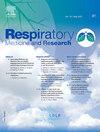Impact of the COVID-19 pandemic on lung cancer diagnosis, treatment, mortality, and survival in Belgium: A population-based study
IF 1.8
4区 医学
Q3 RESPIRATORY SYSTEM
引用次数: 0
Abstract
Background
We evaluated the impact of COVID-19 on the care pathway and outcomes for patients diagnosed with lung cancer in 2020 in Belgium.
Methods
Lung cancer patients diagnosed in 2017–2020 were extracted from the nationwide Belgian Cancer Registry database. Characteristics and treatment of patients in 2020 were compared with 2017–2019 at semester level (January-June: S1; July-December: S2). 90-day post-operative mortality and relative survival (RS) at 1 and 3 years for 2020 were compared with the 2017–2019 trend.
Results
The study included 29,721 patients diagnosed with lung cancer in 2017–2020. Patients diagnosed in 2020 had a poorer WHO Performance status and more often distant metastases compared to the corresponding semester in 2017–2019. In 2020 S2, there was slightly less surgery performed in patients with early-stage (I-II) lung cancer in favour of radiotherapy (RT) (surgery:4.7 percent-points, RT +6.0 percent-points, p = 0.001). RT courses had a shorter median duration (S1:4 days; S2:4 days) and lower median number of fractions (S1:5; S2:5). The unadjusted 90-day post-operative mortality increased, but this increase was no longer significant when adjusting for case-mix (unadjusted: Odds ratio (OR) =1.85 [1.05–3.24]; adjusted: (OR 1.78 [0.99–3.21]). There was no significant change in RS at 1 and 3 years, with or without case-mix adjustment (unadjusted: 1-year excess hazard ratio (EHR)=1.06 [1.00–1.12], 3-year EHR=1.05 [1.00–1.11]; adjusted: 1-year EHR=1.02 [0.96–1.08], 3-year EHR=1.02 [0.96–1.07]).
Conclusion
Lung cancer patients in Belgium experienced only minor changes in their care pathway during the COVID-19 pandemic. The changes in stage distribution and the increase in 90-day postoperative mortality warrant monitoring of long-term outcomes.
COVID-19大流行对比利时肺癌诊断、治疗、死亡率和生存率的影响:一项基于人群的研究
背景:我们评估了2019冠状病毒病对比利时2020年肺癌患者护理途径和结局的影响。方法:从比利时全国癌症登记数据库中提取2017-2020年诊断的肺癌患者。以学期为单位(1 - 6月:S1; 7- 12月:S2)比较2020年与2017-2019年患者的特征及治疗。将2020年术后90天死亡率和1年和3年相对生存率(RS)与2017-2019年趋势进行比较。结果:该研究纳入了2017-2020年诊断为肺癌的29,721例患者。与2017-2019年相应学期相比,2020年诊断出的患者的世卫组织绩效状况较差,远处转移的情况也更多。2020年,早期(I-II)肺癌患者的手术治疗略少于放疗(RT)(手术:4.7个百分点,RT +6.0个百分点,p = 0.001)。RT疗程的中位数持续时间较短(S1:4天;S2:4天),分数中位数较低(S1:5; S2:5)。未调整的术后90天死亡率增加,但在调整病例组合后,这种增加不再显著(未调整:优势比(OR) =1.85 [1.05-3.24];调整后:(OR 1.78[0.99-3.21])。无论是否进行病例组合调整,1年和3年的RS均无显著变化(未经调整:1年超额风险比=1.06[1.00-1.12],3年超额风险比=1.05 [1.00-1.11];调整后:1年EHR=1.02[0.96-1.08], 3年EHR=1.02[0.96-1.07])。结论:在2019冠状病毒病大流行期间,比利时肺癌患者的护理途径仅发生了微小变化。分期分布的变化和术后90天死亡率的增加需要对长期预后进行监测。
本文章由计算机程序翻译,如有差异,请以英文原文为准。
求助全文
约1分钟内获得全文
求助全文
来源期刊

Respiratory Medicine and Research
RESPIRATORY SYSTEM-
CiteScore
2.70
自引率
0.00%
发文量
82
审稿时长
50 days
 求助内容:
求助内容: 应助结果提醒方式:
应助结果提醒方式:


